(单词翻译:单击)
To accompany our cover article on regional food specialties around France, we asked some food experts to weigh in with their tips for must-eats in other parts of the world. Following is a selection.
为了配合本期以法国各地特色美食为主题的封面文章,我们请教了一些美食家,请他们推荐世界其他地方不可错过的美味。下面是几条精选。
Also, share your favorite regional dishes in the comments section.
此外,您可以在评论区与大家分享你钟爱的各地小吃。
Mohinga in Myanmar
缅甸的鱼板面
Tender rice noodles in a slightly pungent yet delicate fish broth, dotted with chunks of green banana stem, may not be everyone's idea of breakfast food, but mohinga, a classic morning-time food in central and southern Myanmar, is a great way to start the day. It comes in many versions. In Yangon, formerly Rangoon, the broth is made aromatic with lemon grass, ginger and garlic. On the west coast, in Rakhine State, it's topped with flaked cooked fish and a dollop of chile paste.
柔软的米粉浸在微辣却美味的鱼肉汤里,点缀着几块绿色的香蕉茎,这就是鱼板面。也许它并不是人人喜爱的早餐食品,但作为缅甸中部与南部的经典早餐,的确是启动一天的绝佳方式。鱼板面有很多版本。在仰光,肉汤中要放入柠檬草、生姜和大蒜调味。在缅甸西海岸的若开邦,鱼板面上要盖一层熟鱼片和一团辣酱。
Mohinga is sold by streetside vendors and in some teashops. Pick a place already busy with locals. The vendor will put a tangle of rice noodles in your bowl, pour over the hot broth, add a sprinkle of cilantro, a section of hard-cooked egg, some minced scallion greens and perhaps some slices of fish cake. You can then choose one or more deep-fried toppings.
鱼板面在街边小摊及茶馆里都可以买到。找一个已经坐满了本地人的红火摊位坐下,小吃摊老板会在把一把米粉放进碗里,倒上滚烫的鱼汤,撒一把香菜、葱花、半个全熟的水煮蛋,或者还会几片炸鱼饼。然后你可以选择一种或几种油炸的食品盖在上面。
In Yangon you'll find busy mohinga stands along downtown Maha Bandoola Road, and along small side streets. My favorite is called Ou Yi, in a tree-lined yard by a side lane off Inya Road. The mohinga costs more than the usual streetside fare — the equivalent of $2.50 rather than $1. This is shocking to locals, but for travelers it's the best kind of bargain: the broth has a wonderful balance and freshness that is deeply satisfying. Ou Yi is open at 5:30 every morning. Get there before 9 a.m. — they tend to run out early.
在仰光,你会在闹市区的华人街及小巷内发现许多繁忙的鱼板面摊位和店铺。我最爱的那家是“藕艺”(音译),位于茵雅路(Inya Road)附近一条小巷内绿树成行的院落里。这里的鱼板面比街边小摊上的通常贵一些。街边一份只要1美元,而这里要2.50美元,在本地人看来是天价,但在游客眼中极其划算:肉汤鲜美可口,恰到好处,令人非常满意。藕艺每天早上5:30开门。最好在上午9点之前去,这里的店铺开张都很早。
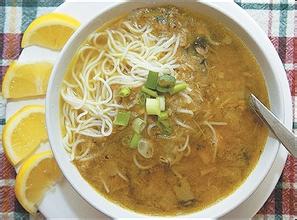
Far from Yangon, there is outstanding mohinga at the main market in Nyaung Shwe, near beautiful Inle Lake — but only every five days; "market day” rotates around the region. Head up the main aisle of the market building; just before you reach the end, you'll see to your right a huge wok full of tomato-tinged mohinga broth. Pull up a stool and tuck in. There's a layered perfume to the fish broth, a delicate blend of lemon grass, shallots, tomato acidity and something more (perhaps a secret local herb?) that sings on the tongue. You'll be back for more.
除了仰光,在美丽的茵莱湖(Inle Lake)附近,娘乌镇(Nyaung Shwe)的大集市上亦有极好的鱼板面,但这个集市五天才有一次。“赶集日”在这片地区各处轮转。沿着集市大楼的主通道向前走,快到头的时候,你会发现右手边有一口巨大的锅,里面盛满了番茄色的鱼板面肉汤。拉过一张凳子,大快朵颐吧。鱼汤的香味层次无穷,丰富微妙,混合着柠檬草、青葱与西红柿的酸甜,还有些别的味道(或许是本土的秘密草药?),一起在舌尖上载歌载舞。你肯定会多次回来,享受这种美味。
Naomi Duguid, the author of "Burma: Rivers of Flavor.”
奈奥米·达贵德(Naomi Duguid),《缅甸:香味的河流》(Burma: Rivers of Flavor)的作者。
Kibbe Nayyeh in Antelias, Lebanon
黎巴嫩山省(Antelias)的生肉饼
Kibbe, a subtly spiced mixture of minced lamb and bulgur wheat, can be found around the Levant, cooked in myriad ways. It can also be served raw, as kibbe nayyeh (nayyeh means raw in Arabic), often called the national dish of Lebanon. It's sometimes referred to as Arab steak tartare, although it is smoother and spicier — the meat is moistened with olive oil instead of egg yolk, and should ideally be pounded in a marble mortar with a heavy wooden pestle until it turns into a silky paste. I can still picture my Lebanese mother and grandmother sitting on low stools on either side of a beautiful large mortar taking turns to pound the lean chunks of lamb with a big wooden pestle.
吉布(kibbe)是一种用羊肉馅和小麦碎加丰富香料制成的食物,是黎凡特一带的特色小吃,烹饪方法很多。有时候可以把生肉直接上桌,名叫生肉饼,或者叫“吉布纳耶”(Kibbe Nayyeh;Nayyeh在阿拉伯语中意为生肉),人们常常称它为黎巴嫩的国菜。有时候,吉布纳耶指的是阿拉伯鞑靼肉排,尽管会更为滑嫩香辛——因为里面用来增加肉馅湿度的是橄榄油而不是蛋黄,理想的情况下,应当是把肉馅放在石臼内,用沉重的木杵反复捶打敲击,直到肉馅成为丝滑的糊糊。一台精美的大石臼,我的黎巴嫩母亲和祖母分别坐在两旁的矮凳上,轮流用大木捶打一块块精瘦的羊羔肉,这个画面至今历历在目。
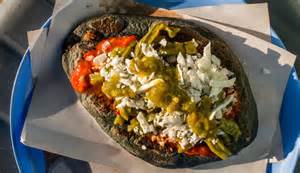
As you can imagine, this took quite some time and hardly anyone these days makes kibbe nayyeh by hand, least of all restaurants. But some, like Al-Halabi, a timeless restaurant in Antelias, a northern suburb of Beirut, manage to achieve the same smooth texture despite mincing the meat in a grinder. Its kibbe nayyeh is one of the best in town: as silky as the one I remember from my youth, with the same lovely pale pink color, a sure sign it is mixed just before it is served, with a little iced water added to keep the color and loosen the meat. Al-Halabi also uses a minimal amount of bulgur wheat, which allows for a meatier texture. And the seasoning is subtle, with enough spices to enhance the flavor of the lamb but not overwhelm it.
正如你想象的,这个过程非常耗时,因此现在几乎没人用纯手工制作生肉饼了,尤其是餐馆。但也有例外,比如山省贝鲁特北郊有家不合时宜的艾尔哈拉比餐厅(Al-Halabi),虽然用了研磨机来制作肉馅,但出产的生肉饼的质地与手工制成的一样嫩滑。它的生肉饼是镇里最美味的:和我青春记忆中最香的肉饼一样丝滑,有同样可爱的淡粉色泽,见到这种色泽,你就可以确信它是做成之后立马新鲜上桌的。还加了一点冰水用来维持色泽,同时让肉馅松软。艾尔哈拉比用的小麦碎也是最少的,小麦碎的作用增加肉的质感。调味料加得恰到好处,既能丰富羊肉的浓香,又不至于盖过它本来的滋味。
ANISSA HELOU, the author of "Levant.”
阿尼莎·西露(Anissa Helou),《黎凡特》(Levant)的作者。
Piti in Kars, Turkey
土耳其卡尔斯的炖羊肉(piti)
In Kars, a northeastern Turkish province where dairy and cattle ranching dominate, one local specialty stands out for its unlikely main ingredient: lamb. Piti, a stew of chickpeas, mutton and tomato in a broth flavored with sheep tail fat and sarikok, or dried turmeric, embodies the region's past as a Silk Road way station and, for four decades around the turn of the 20th century, a Russian territory. The dish originated in Azerbaijan, though piti there is sometimes flavored with saffron instead of turmeric. Tomato, a novelty in Turkey's remoter provinces until well into the 20th century, is probably a recent addition.
土耳其东北部省份卡尔斯的支柱产业是奶制品和畜牧业,这里有一种特色食品因其主料脱颖而出——羊羔肉。这种特色美食就是炖羊肉(piti),一种炖制食品,在汤汁中放入羊尾油和姜黄粉,加鹰嘴豆、羊肉和西红柿一起炖。这道菜体现了此地作为丝绸之路重镇的历史,而且,在20世纪转折点前后,它有40年时间属于俄罗斯的疆土。这道菜源于阿塞拜疆,只不过在那里,炖肉料加的是藏红花,而不是姜黄。至于西红柿,土耳其一些边远省份直到20世纪才引进这种蔬菜,因此,炖羊肉中的西红柿可能是近年来才增加的。
Piti is baked in small single-serving vessels — metal cups in Kars and clay dishes in Azerbaijan — and is served with broth strained from the meat and chickpeas. In Kars it is poured over torn strips of lavash mounded in a shallow bowl. Absorbing the liquid, the bread becomes a dumpling-like cloud redolent of meat juices, with a slight musty-bitter edge from the turmeric. Some diners make it a one-dish meal by placing meat and chickpeas on top of the lavash and mashing the legumes into the bread, while others eat the two side by side. Though the hearty dish is served year-round it's especially suited to Kars's notoriously long and harsh winters.
炖羊肉盛在单独的小容器(在卡尔斯是搪瓷茶缸,在阿塞拜疆则是瓷盘)中,按份烹制。端上餐桌时,盛些加有鹰嘴豆的肉汤浇在上面。在卡尔斯,是将面饼撕成片,堆在空碗里,然后浇上肉汤。面饼吸收肉汤之后会膨胀成饺子形状的馍块,散发出肉汁的浓香,姜黄带来一丝苦涩而陈旧的口感。有些顾客会把肉块与鹰嘴豆放在馍块上面,将豆子压到泡馍里,这样它就成了一道菜。还有一些顾客喜欢将这两样食品分别食用。尽管这种丰盛的美味全年都有供应,但它尤其适合卡尔斯漫长而凛冽的寒冬。
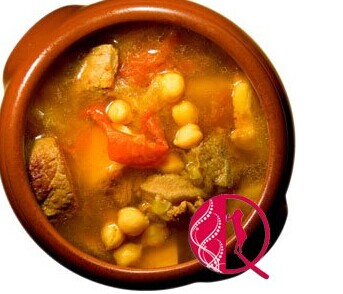
Kristal Lokantasi is one of the last restaurants in the drowsy provincial capital (also called Kars) to serve piti. Tahsin Kaya, the owner, said that his version, available for lunch only, is prepared using the same recipe as when his father opened the establishment, in a storefront down the street, over 50 years earlier. It sells out daily, even in summer, when temperatures can hit the 80s.
洛坎塔西餐厅是这座乏味的省会城市(卡尔斯省的省会,名字也叫卡尔斯)中硕果仅存的仍可烹制炖羊肉的几家饭馆之一。老板塔辛·卡雅(Tahsin Kaya)说这里只有午餐才供应炖羊肉,配方与他父亲50年前开店时完全相同。当年,它只是街边的一个小门店。该店的炖羊肉每天都供不应求,哪怕是气温80华氏度以上的盛夏时节。
ROBYN ECKHARDT, writer and blogger, EatingAsia.
罗宾·艾克哈特(Robyn Eckhardt),美食亚洲(EatingAsia)的作者与博主。
Tlacoyos in Mexico City
墨西哥城的脆皮馅饼(tlacoyo)
People have been eating tlacoyos — masa patties stuffed with either refried beans, a salty, spreadable cheese called requesón, or mashed fava beans — in one form or another since pre-Hispanic times, and they are still sold at sidewalk stands across Mexico City. Female vendors hand-pat the corn dough into the shape of a flattened football and then cook the patties until crisp and freckled on both sides, often at charcoal grills that sit inches from their laps. The toppings, though, push tlacoyos into the upper echelon of Mexico street food: cooked cactus strips, fresh onion and cilantro and a spoonful of salsa.
从前西班牙时代开始,人们就开始吃脆皮馅饼,模样虽然各异,但直到今天,墨西哥城的路边摊仍在兜售。面皮中间填塞的要么是炸豆泥,一种名叫雷却桑(requesón)的易于涂抹的咸味奶酪,要么是蚕豆泥。小吃摊老板娘用手把玉米面团拍成漏气足球的模样,然后将这团生面饼放在几英寸外的木炭烤架上烤至焦脆,两面都布满均匀的斑点。可是让脆皮馅饼在墨西哥美食街独占鳌头的,是其中的馅料:煮熟的仙人果丝、新鲜的洋葱、香菜和一勺莎莎辣酱。
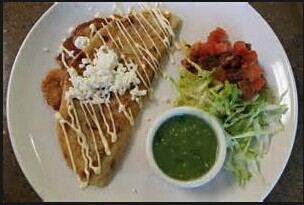
My favorite stand is run by Rosa Pe?a Sotres, who typically wears her gray hair in a braid. To find her, you get off at Metro Salto del Agua and head north on bustling Calle López. Her stand sits near Calle Delicias, just before the carnitas stand with the big clay pots. Ms. Pe?a Sotres has made tlacoyos for decades (her mother made them before her) and her skill comes across in each bite. The blue corn masa, which she prepares herself, is fluffy and airy; the fava beans add moisture and a nutty sweetness. When she asks, "Con todo?" the answer for me is always yes.
我最爱的摊位是罗莎·佩纳·索翠思(Rosa Pe?a Sotres)开的,她经常把灰色的长发编成辫子。如果你想找她,需要在索托戴尔阿瓜(Salto del Agua)地铁站下车,向南沿着熙熙攘攘的洛佩兹大街(Calle López)直走。她的摊位就在德莉希亚大街(Calle Delicias)附近,下一个摊位卖的是卡尼特斯玉米卷,有几个大陶罐。佩纳·索翠思女士制作脆皮馅饼已经好几十年了(过去是她的母亲在做),每尝一口,你都能感受到她高妙的手艺。揉好备用的蓝色玉米面团松软多孔,里面的蚕豆为其增添了一份润泽的口感与坚果的甘甜。每当她问:“还要吃?”我的回答永远是“对”。
I loved her tlacoyos so much that I asked her if she accepted students. Soon afterward I found myself in the spotless patio of her house, in a nearby town. She showed me how she grinds her beans on a ground stonetool called a metate — brushing the stone cylinder against the base with sharp, quick motions — and the correct way to place the tlacoyos on the grill, first in the center, then off to the edges. After making a few dozen tlacoyos, my feet and back hurt. Ms. Pe?a Sotres had barely broken a sweat.
她的脆皮馅饼我实在太喜欢了,就问她能不能收我为徒。片刻之后,我就来到了附近小镇里她家一尘不染的露台上。她为我演示怎样用一种叫做凹面磨盘的石具磨豆子——用快速而敏锐的动作将石柱顶在基底上摩擦,以及怎样把脆皮馅饼放在烤架上才正确——首先放在中间,然后慢慢向四边铺开。做了几十个脆皮馅饼之后,我的双足和背部开始隐隐作痛,佩纳·索翠思女士却泰然自若,几乎一滴汗水都没出。
LESLEY TELLEZ, writer and blogger, The Mija Chronicles.
莱斯利·泰勒兹(Lwsley Tellez) ,美子编年史 (The Mija Chronicles)网站的作者与博主。
Porchetta in Umbria, Italy
意大利翁布里亚的脆皮烤猪肉
In the ancient town of Bevagna in central Umbria, down a narrow and winding street, is a magnificent butcher shop called Macelleria Tagliavento. Head through the modest and dimly lit space, perfumed by cured meats hanging overhead, and you will find a delicatessen case filled with yet more meat. Past that, perched on a ledge, is a particularly magnificent porchetta. I grew up mostly around central Italy, and this version is the type I remember loving before industrialized methods took over.
在翁布里亚中部的贝瓦尼纳古城,沿着一条狭窄而曲折的街道向前走,就会看到一家气派的肉店,名叫塔利亚文托肉店(Macelleria Tagliavento)。朴素幽暗的店内挂满了腌肉,穿过这香浓的气息,你会发现一个熟食柜台,里面摆放的肉更多。走过柜台,壁架上摆着一盘十分华丽的脆皮烤猪肉。我的童年与少年基本是在意大利中部度过,这种烤肉的方式正是我过去深爱的那种,可惜后来都被工业文明取代了。
Porchetta — a deconstructed whole pig, gutted and spiced, then stuffed, tied and roasted, with layers of meat, fat, stuffing and skin — originated in the area around Rome and in the former Vatican states. These days, it's available all over Italy, including in Bevagna, in the heart of one of the most famous pork-curing regions of Italy. At Macelleria Tagliavento, the skin, glazed and crispy, covers perfectly moist flesh; traditional organ meats, wild fennel pollen, garlic, rosemary and lots of salt and pepper hide inside. The head is left attached for extra-dramatic presentation. It's usually sold out by noon.
脆皮烤猪肉是将一只整猪拆散,去掉内脏,加上香料腌制,然后填上馅料,绑在一起烤制而成,瘦肉、肥肉、馅料和脆皮层次分明。这种烤法发源于罗马一带与前梵蒂冈各州。而今,意大利各地都可烹饪这种菜肴,包括贝瓦尼亚,意大利名气最大的养猪区的中心地带。塔利亚文托肉店的烤猪肉脆皮晶莹酥脆,恰到好处地盖住了鲜嫩多汁的瘦肉;藏在里面的则是传统的有机瘦肉、野生茴香粉、大蒜、迷迭香和大量的盐和胡椒。猪头也留了下来,展示时显得格外生动。这份烤猪肉一般不到中午就能卖出去。
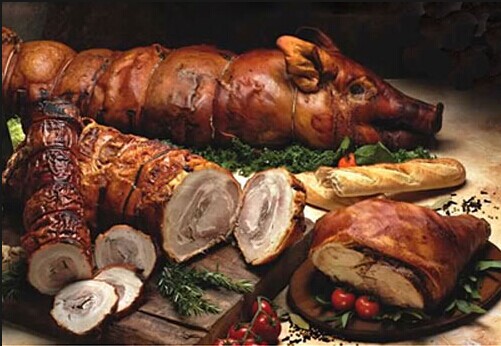
Marco Biagetti and Rosita Cariani, the owners, cut the porchetta by hand and use thick slices from a great round loaf of artisanal bread. After wrapping the sandwich in a little butcher paper, they will send you on your way into the street, blinking in the bright light.
店主马可·比亚盖提(Marco Biagetti)与罗西塔·卡瑞阿尼(Rosita Cariani)亲手切下肉片,用厚厚的面包片夹起来。那是用一大块工艺圆面包切成的。他们用一小块包肉纸把这份三明治包好递给你,目送着你走进大街,他们的眼睛仍在明亮的灯光下闪闪发光。
SARA JENKINS, the chef at Porsena and Porchetta in New York.
莎拉·詹金斯(Sara Jenkins),纽约波西那与波尔凯塔餐厅(Porsena and Porchetta)的主厨。


